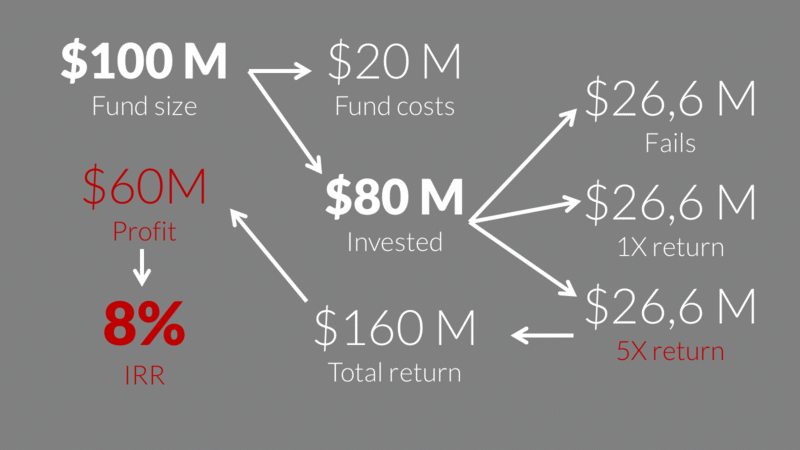ACTIVIST VC BLOG

Why VC’s seek 10x returns
January 12, 2018When a VC firm turns down an investment claiming that there is not good potential for 10x return, the reaction is sometimes pretty incredulous. From a founder’s perspective, building a business that creates a 5x return on investment might sound very good.
To understand why VCs seem to seek very high multiple returns, we need to look into the VC business model.
The ‘two and twenty’ model
Most VC business models have three key elements:
- A management fee
- Profit share (called often carry or carried interest)
- VC firms own direct investment to the fund
This model tries to balance the need to generate good returns for the investors of the VC fund (often called “Limited Partners” or “LPs”) and the necessity for the VC firm to cover its operational expenses.
1. The management fee: An annual fee covering the cost of daily activities but does not generate profit for the VC firm: during the investment period typically a bit more than 2% of the total fund size – hence “two”.
2. Carry – the profit share: The profit of a VC fund (i.e. returns in excess of the original investments) is typically divided between the Limited Partners and the VC firm in an 80/20 split (the “twenty”). Additionally, most funds have a hurdle rate; an internal annual rate of return the VC firm must deliver to LPs before starting to receive any profit. Hurdle rates are typically around 7-8%.
3. Direct investment: Investors sometimes insist the VC firm co-invests substantial amount capital into the fund. By having some real skin in the game and sharing also the risk element in the business, the VC team’s incentives are better aligned with the investor’s.
Wait, that’s not all
The typical lifetime of a VC fund is 10 years. The management fee and other fund costs during those ten years take almost 20% of the fund capital and only 80% is left for investments.
And startup investing is inherently risky; not all investments are successful. A very rough rule of thumb is that:
- one third of investments fail altogether
- one third returns just the capital invested
- one third is successful
(The risk profile of the investment strategy naturally impacts the success ratio. The predicted success ratio has again a direct impact on targeted return multiples – and the meaningful minimum size of the portfolio – when defining the investment strategy for a fund.)
So, 5x gives us nothing*
If a VC firm returns 5x on its successful investments, the VC firm will get nothing: the internal rate of return (IRR) of the fund is 8 % and all of the profit would go to LPs to cover the hurdle rate. The 8% IRR is not optimal result from the LP perspective either: VC funds are a high risk asset class and should generate better returns to justify the risk.
But if the return on successful exits is 10x, the fund returns 3x the fund size and IRR goes up to 20%. The LPs get a good return on their investment and the VC firm gets reasonable profit. And, obviously, the founders of the company have their payday.
So, the 10x target is not a matter of greed – the high risk profiles of startups combined with the VC business model simply requires this level of returns.
In fact, many professional early stage investors state that their targeted return is 30x, reflecting the even higher risk levels faced by these very early stage investors. This also results in fairly large portfolios – maximizing odds catching at least one or two of those so scarce winners or even unicorns…
Stay tuned and subscribe, new Activist VC blogs coming out on weekly bases!
* These scenarios assume:
- 20/80 split between fund costs and money invested in portfolio companies
- an even 1/3 distribution between failures / even money / successful exits
- a 6-year average holding period for the capital
- 8% hurdle rate






1/3, 1/3, 1/3 may be good figures to show LPs to raise a fund but do not reflect reality neither in the EU nor in the US, where ‘successful’ exits are less than 1 in 3.
Once one starts taking an honest look at returns (i.e. Distributions to Paid-in Capital, TVPI typically vastly overestimates actual returns to investors) one realizes that the average early VC fund will never hit a hurdle rate of 5%, let alone 8%, unless it is lucky to have an outlier in its portfolio. Investing in such a VC then starts looking a lot more like buying a ticket at the lottery or betting on horses than an investment.
See for instance PitchBook Benchmarks for actual data.
Hi Jack and thanks for your professional feedback!
I fully agree that 1/3, 1/3, 1/3 split of lemons / 1 x returns / successful investment is not a realistic target for a typical early-stage VC fund. As I state in the blog posts: “The risk profile of the investment strategy naturally impacts the success ratio.”
If you click the underlined words “The risk profile” in my blog post, a small pop-up window opens up clarifying my views a bit further: “In early-stage B2C investments, the success ratio can be low – far less than one out of ten. Then again, on later stage B2B investments the success ratio might be above 50%. An example: our B2B investments of the latest fund – we have no total failures and over 50% of the deals are successful.”
So yes, I fully agree: if the investment strategy of a VC fund is more about high-risk investments (like they very typically are: early-stage B2C deals etc…) the success ratio and return multiple targets should be adjusted accordingly.
Best,
Artturi
Hi, Artturi,
When we talk about ’10x’ or ’30x’ returns, is it a metric measuring the ratio of cash invested by the VC to cash recuperated upon exit, of the pre-money valuation at time of investment to the pre-money valuation at the time of exit, of the same for post-money, or something else?
Thanks for your help.
-F
Hi Florent and thanks for asking!
With 10x return we mean the return multiple of the total investment from our VC fund perspective. Example: We invest a total of $10 million to a company (we often invest in several tranches and using different valuations in different rounds). In the end, our share of the exit proceeds of the company is $100 million, so we get a 10x return on our $10 investment. Hope this clarifies?
Hi Artturi,
I was confused by the “8%” calculation. Because IRR will take into account the time value of the money, and I think in your calculation it seems time does not appear. For example, if a project achieves 5X performance at the end of 6th year, how does that project grows over time? 1st year 2X and 2nd year 4X, or 1st 1.1x and 2year 1.2x. The same 5x will result in different IRR because the growth route during the 6 years. Look forward to you reply~
Hi Artturi,
Sorry to bother you again as I’ve sent a comment yesterday. It’s about the IRR calculation. Yesterday I asked about the time effect on IRR and soon I found that’s not a problem as we presume all earnings are gained at a steady pace year by year. But at the bottom of the blog the picture that illustrates 193M profit and 20%, I think this IRR is calculated on a 6-year basis? But seems the fund costs are calculated at a 10-year basis, so I was a bit confused. Can you please explain a bit